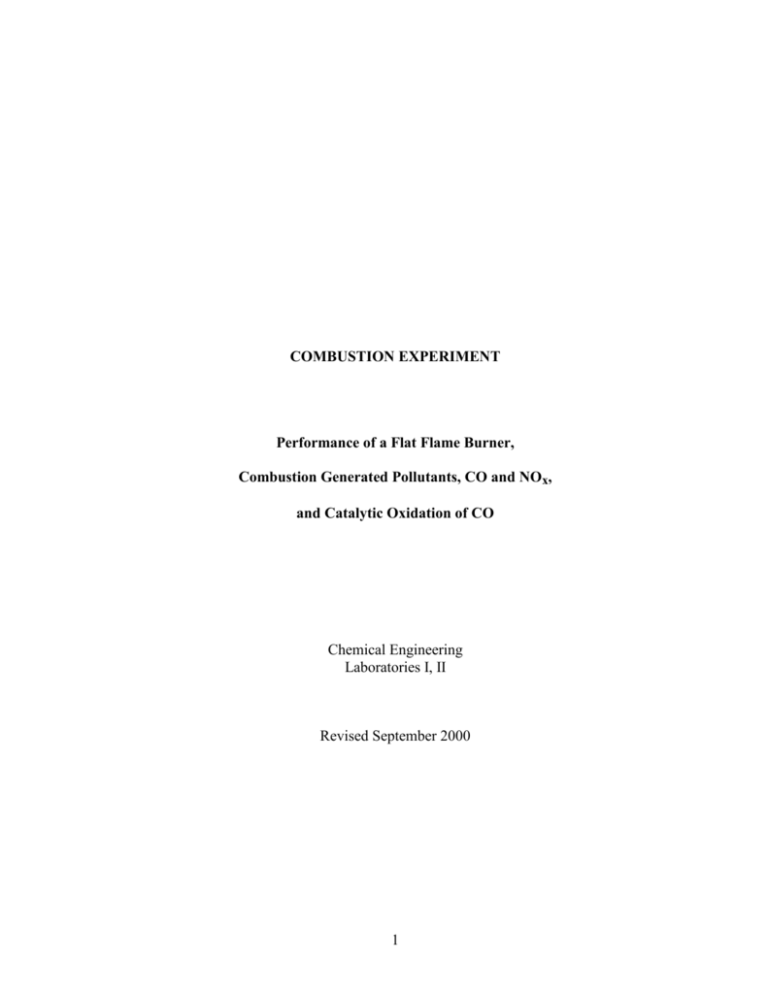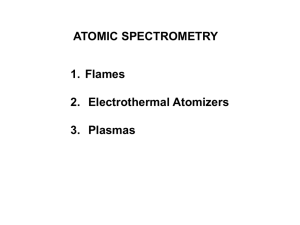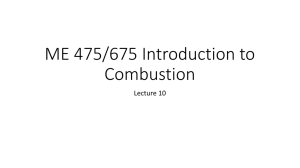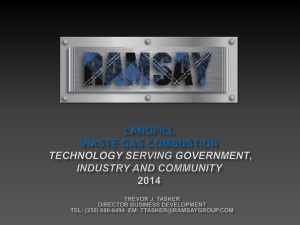Combustion
advertisement

COMBUSTION EXPERIMENT Performance of a Flat Flame Burner, Combustion Generated Pollutants, CO and NOx, and Catalytic Oxidation of CO Chemical Engineering Laboratories I, II Revised September 2000 1 TABLE OF CONTENTS OBJECTIVE SESSION I Preliminary-Overview/Objectives A. Combustor Assembly/Analytical Equipment B. Dimensions - Combustor, Catalyst C. Operations/Calculations SESSION II - Laboratory SESSION III - Report Calculations a) b) c) d) Burner Performance/Pollutant Generation Catalyst Performance Questions to be addressed Oral Presentation SESSION IV - Executive Summary REFERENCES 2 COMBUSTION EXPERIMENT Combustion is a combined Unit Operation and Unit Process of unsurpassed importance to modern civilization and technology. The linkages between practical devices, combustion phenomena, and the underlying scientific and engineering disciplines are illustrated in Figure 1. Combustion is the rapid conversion of fuel and oxygen to carbon dioxide and water in the presence of a flame. It can also be a major source of several pollutants. OBJECTIVES In this experiment propane will be burnt in a flat flame burner to evaluate burner performance and pollutant emissions, such as carbon monoxide and nitric oxide. A second objective is the performance of a fixed bed catalyst for carbon monoxide conversion (to CO2). Session I Preliminary - Overview/Objectives This session is to acquaint you with the detailed objectives of the experiment, the equipment, and the data to be taken. You should become familiar with certain definitions and combustion terminology such as: stoichiometry, equivalence ratio, adiabatic flame temperature, volumetric and surface heat release rates, flame velocity, stack draft, fuel types and composition, etc. Consult the reference list at the end of this handout for background and some theory. In addition to these books there are two premier journals in the combustion field: Combustion and Flame; Combustion Science and Technology. A. Combustion Assembly/Analytical Equipment A flat flame burner (Figure 2) is used to combust a light hydrocarbon gas, propane, C3H8. The flame is essentially very thin, i.e., quasi-onedimensional. The combustor assembly is shown in Figure 3. It consists of a platform upon which the burner is mounted. The burner is topped by a short quartz glass chimney (27 cm high) with a transition to a galvanized steel ducting section (70 cm). This section includes a cooling coil (water) which may be used to regulate catalyst inlet and outlet temperatures (T3 & T4), as well as an air inlet. This is followed by a flanged stainless steel section containing the catalyst (cf. catalyst description below) and from there to galvanized exhaust ducting. To the right of the burner table are three flow meters and associated valves to control cooling water, and reactant (propane and air) flowrates, respectively. In lieu of one or more of these flow meters, mass flow controllers may be used. THE TA WILL INSTRUCT IN THEIR USE AND SETTINGS. The burner surface temperature is controlled by cooling water flowing through the base of the burner. Thermocouples T1 and T2 measure the water T in and out, respectively. Propane and air are controlled separately and are mixed in the base of the burner, prior to ignition with an electric spark. Downstream from the flame are several ports which are used for temperature measurements (via thermocouples) and gas sampling. The principal fixed sampling probes are located upstream and downstream of the catalyst, together with thermocouples T3 and T4, respectively (Figure 3). These gas sampling lines connect to a pair of valves (located on the left front side of the support 3 frame), which can be set to the desired sampling location (pre-or postcatalyst). For this experiment, the second value should be set to "COMBUSTION". From here, all samples taken go through a sample conditioning train (located below the burner table). The principle function of this train is the removal of water prior to entry of the noncondensable gas stream containing CO2, CO, and NO (in addition to N2 and any O2 not consumed) into the gas analyzer modules. To the right of the burner table a movable console is located which holds three gas analyzers for carbon dioxide, carbon monoxide, and nitric oxide measurements (Figure 4). These measurements are displayed continuously on each gas analyzer's screen and the computer monitor. Part of your task will be the measurement of these pollutants under a variety of burner operating conditions. This monitor is mounted on another console and - in addition to the above gases displays temperature (from all active thermocouple locations) in real time. Under appropriate conditions, such as < 1 (= equivalence ratio) the catalyst - converts carbon monoxide to carbon dioxide. As part of this experiment you will evaluate the catalyst performance as a function of inlet (T3) and outlet (T4) temperatures, inlet CO-concentration and space velocity, at several equivalence ratios. B. Dimensions - Burner Base - 120 mm Inside diameter - 62.5 mm Sampling probes are located below the catalyst (precatalyst, T3) and after the catalyst (post catalyst, T4) close to the respective thermocouples. Glass chimney - 125 mm (i.d.) - Honeycomb Catalyst (Pt/alumina) Bed Length Bed Diameter Individual Channel area (open squares) % open C. 160 mm 70 mm 1.75 x 1.75 mm2 90 Operations/Calculations Operation of all equipment and instrumentation should be reviewed during Session I. The TA will demonstrate the operation of the burner, thermocouples, gas analyzers, suitable operating ranges, and the sampling train. Assignments should be made during this preliminary session of tasks to be performed by each group member during the lab session. These assignments and their execution are critical to the success of Session II. 4 Using typical assigned flow meter or mass flow controller (propane and air ranges) settings (cf. below), calculate flowrates for a series of equivalence ratios and the expected CO2-concentrations (assuming complete conversion of propane to CO2). The actual settings which may require pressure/ temperature corrections, are read directly in lpm (liters per minute at standard conditions from the rotameters). Calculate equivalence ratios PRIOR TO THE LABORATORY SESSION. Note the location of the propane supply (tank to left rear). Session II - Laboratory You must have the calculations described below completed before entering the laboratory to run the experiment! Before the beginning of the laboratory session, the teaching assistants will have lit the burner to equilibrate the system with the surroundings. Exhaust fan must be on. Record the ambient temperature, pressure, and water flow rate (this value should be 2 lpm). Safety is very important for this experiment. One group member should always be watching the flame in case it goes out. If so, that person should immediately turn off the propane supply using the valve on the top of the propane tank. Note: turning off the propane supply is the only time a student may be behind the combustion platform. The teaching assistant then should be notified to relight the burner. Experimental Variables: 1) Fp = propane flow; Fa = air flow (lpm). With constant propane flowrate of Fp = 0.6-0.7 lpm, choose 3-4 values of the equivalence ratio in the range 0.5 1.1. Calculate the corresponding air flow rate, Fa. Set the flow rates and allow the system to come to steady state (steady flame and constant CO2). Record (on the computer and in your laboratory notebook) all system temperatures, precatalyst gas concentrations (CO, CO2, NOx). A sample data sheet is shown in Figure 5. Record flame characteristics such as thickness, distance from burner, coloration, and geometry (flat, bumpy, wavelets, etc.). Make estimates only from in front of the combustion platform! 2) With a constant air flow rate (Fa near the lower bound given below) choose 3-4 values of the equivalence ratio in the range 0.5 1.2. Calculate the corresponding propane flow rate, Fp, which must be in the range 0.6 Fp 1.l lpm. Record all of the system temperatures and all of the precatalyst and postcatalyst gas concentrations. 3) With a constant = 1.0, choose 3-4 values of the propane flow rate in the range 0.6 Fp 1.0 lpm. Calculate the corresponding Fa. Record data as in step 2. 4) With a constant at some value less than 0.9, choose 2 values of Fa which differ by 5-10 lpm. Calculate the corresponding Fp. Record data as in step 2. 5 5) For a low-mid range Fa-value (14-20) gradually increase Fp so that > 1.2. Observe the color and behavior of the flame. The reported sooting limit for propane is = 1.56. (Sooting is the incipient formation of carbon particles.) See if you can approach it. In this portion of the experiment the flame must be observed very closely; it may go out (note instructions above if that occurs). Try again, beginning at 1.2. If unsuccessful a second time, abandon this portion. Even if unsuccessful, this portion must be followed by a run at < 1.0 for 15 minutes. Otherwise, soot may accumulate in the catalyst bed. 6) In addition to the data to be collected as outlined in steps 1-4 above, some of those conditions should have the precatalyst gas concentrations measured twice, i.e. measure pre, post, and then precatalyst gas concentrations. Also, periodically throughout the experiment, you should return to a single base set of conditions (Fp and Fa) to check for reproducibility and any changes in the experimental system. Do not exceed the bounds listed under 7 (with the exception of 5., above). 7) For a variety of reasons (can you think of what they might be) T3 T4 during your experimental measurements. For some settings the difference may approach a T of 200o, but for most settings it should be well below 150o. In calculations, use a mean temperature. 0.5 1.2 (cf. 5, above, however) 0.6 Fp 1.1 14 Fa 35 Suggested Operating Ranges: N.B. The temperature at T3 should never exceed 400oC. If it does shut off propane flow and restart (only with a lower Fp and Fa) when the temperature has dropped below 400oC (this temperature may be controlled by the water flow through this section). (fuel/air)actual Equivalence ratio, = (fuel/air) stoichiometric (Fuel/air)stoichiometric assumes complete conversion of propane to CO2 and H2O (for > 1, that means unconverted propane must appear on the product side). Combustion Stoichiometry C3H8 + 5(O2 + 3.78 N2) 3CO2 + 4H2O + 18.9 N2 CO2 100 Combustion efficiency, CE, % = CO CO2 So, at a propane flowrate of 1 lpm, an equivalence ratio, = 1 requires 23.8 lpm of air. If air flow is lowered (or if propane flow is increased), > 1, and not all of the fuel is converted. N.B. On the right rear corner of the burner platform a rotameter is located which serves to supply air needed to oxidize CO to CO2 when the combustion itself is 6 conducted substiochiometric (not shown in Figure 3). This flow may enter either at the igniter inlet or just below the catalyst bed (cf. Figure 3). The setting at all times should be at least 130 (SS-float). Session III - Report Prepare for the interim report by following IIIa and IIIb below, and address the questions in IIIc. . Calculations IIIa. Burner Performance/Pollutant Generation Calculate heat loss through the burner base (BB) using T1 and T2 and Fw and the ratio of heat lossBB to total heat release; equivalence ratios; combustion efficiency; adiabatic flame T (assuming no heat loss) and pseudo adiabatic flame T (based on: Hc - heat loss through burner base; where Hc = heat of combustion of propane at 298 K = 530,600 cal/g mole); residence time from flame surface to T3. Calculate for the observed sooting limit. Plot r (inverse equivalence ratio) calculated from your data against nitrogen mass fraction (cf. reference 1, Figure 3) as shown in Figure 6. N.B. The definition of as given in reference l is not the same as given above. Give a reasonable estimate of an energy balance (heat release vs. all possible heat losses from the total system). Your measured CO- And NO-concentrations are to be compared to calculations based on equilibrium and kinetic rate expressions from the literature, as given in references 2 and 3. Use measured and calculated temperatures in both equilibrium and rate equations. Use pseudo adiabatic flame T for NO-calculations (cf. also reference 5, under General References to Combustion, chapter 4, p. 119, and p. 538, for NO-calculations; copies of this material may be obtained from Prof. Altwicker). Estimate your flat flame (in the absence of cones, bumps, etc.) thickness from = l C po v where = ~ = thermal conductivity of unburnt mixture thermal conductivity of air 7 Cp o v = = = heat capacity gas density gas approach velocity (through burner base) Then calculate a characteristic , flame residence time (you will need this value for calculations of NO-formation). IIIb. Catalyst Performance Evaluate the performance of the catalyst bed for CO-oxidation in terms of equivalence ratios, space velocities, inlet and outlet CO-concentrations (i.e., conversion), inlet and outlet temperatures cf. reference 2, p. 359-364 and reference 6, Chapters 4 and 6. IIIc. Address the following questions: 1. By what mechanism is CO(g) mass transported to the channel wall, where chemical consumption (to produce CO2) occurs? What is the relevant transport coefficient, and to what energy-transfer process and transport property coefficient is this "analogous"? 2. Estimate the Schmidt number Sc /DCO-mix for CO Fickian diffusion through the prevailing combustion gas mixture, using: 1.73 0.216 cm2 T DCO-mix DCO/N2 =~ p • 300 , s where p is the prevailing pressure (expressed in atmospheres) and T the mixture temperature (expressed in kelvins), and = kinematic viscosity. 3. Under typical flow rate, temperature, and pressure conditions found and using the mass transfer equation given below, estimate the catalytic duct length, z, required to consume 95% of the inlet CO concentration, and the mixing cup (bulk) stream temperature at this length. CCO z = exp CCO IN [ 4z - Re Sc d eff ] = 0.05 where deff = 1.75 mm; Re = Reynolds # in catalyst channel. How does this result compare to your experimental results? 4.. If the catalyst were "poisoned" (e.g., by lead compounds), what would happen to the CO exit concentration? Which of the assumptions used in predicting the required converter length, z, would be violated? 8 IIId. This report will be an ORAL PRESENTATION WITH VIEWGRAPHS in which all members of the group are to participate. It is useful if you provide a handout of your overheads. This presentation typically last 50-60 minutes and should include Introduction and Background, Experimental and Analytical System (including positions for measurements), Results, Discussion, Conclusions, References used. Grading emphasis will be placed on the organization and clarity of the presentation. Your grade will be based on this presentation, plus the Executive Summary (cf. below). Questions to Consider: 1. Summarize the purpose of this experiment 2. Be able to explain the general theory of combustion in relation to the experimental setup (what are the advantages of a flat flame burner?) and the parameters measured, including definitions of, for example a. b. c. d. Stoichiometry of combustion reactions Burning velocity Diffusion flame vs. premixed flame The three T's of combustion (time, temperature and turbulence) e. f. g. h. i. Equivalence ratio and its significance to pollutant formation Adiabatic flame temperature Combustion products Heat transfer mechanisms Equilibrium vs. kinetics as related to NO- and CO-formation Discuss the performance of the flat flame burner as shown in Figure 6 and compare to your experimental results. How does flame color relate to equivalence ratio? 3. Catalyst performance and your results. THESE ORAL PRESENTATION TIMES SHOULD BE SCHEDULED SEPARATELY WITH PROF. ALTWICKER. Session IV - Executive Summary Provide a two page Executive Summary of the experiment and your results; you may add one or two figures and/or tables. 9 REFERENCES 1. Vantelon, J.P., P.J. Pagni, and C.M. Dunsky, Cellular Flame Structures on a Cooled Porous Burner. This reference is attached. 2. Cooper, C.D. and F.C. Alley, Air Pollution Control, 2nd Ed., Waveland Press, 1994, Chapters 11, 337-364; Chapter 15, 485-499. 3. Flagan, R.C. and J.H. Seinfeld, Fundamentals of Air Pollution Engineering, Prentice Hall, 1988, Chapters 2 and 3. 4. Prucker, S., W. Meier, and W. Stricker, Rev. Sci. Instrum., 65, 2908-2911 (1994). 5. Senser, D.W., J.S. Moore, and V.A. Cundy, ibid., 56, 1299-1284 (1985). 6. Fogler, H.S., Elements of Chemical Reaction Engineering, Prentice Hall, 1992, Chapters 4 & 6. 7. Holman, J.P., Heat Transfer, McGraw-Hill Inc., 1997. General References to Combustion 1. Glassman, I., Combustion, 3rd Ed., Academic Press, 1996. 2. Chigier, N., Ed., Energy and Combustion Science, Student Edition 1, Pergamon Press, 1974. 3. Borman, G.L.. and K.W. Ragland, Combustion Engineering, McGraw Hill, 1998. 4. Puri, I.K., Ed., Environmental Implications of Combustion Processes, CRC Press, 1993. 5. Turns, S.R., An Introduction to Combustion, McGraw Hill, 1996. This reference has a sample NO-calculation. 10 Figure 1 Combustion Linkages 11 Figure 2 Flat Flame Burner 12 Figure 3 Combustion Assembly 13 Figure 4 Combustion Sampling & Analysis Layout 14 Figure 5 Date psi, Air Pressure (line) psi, Propane Pressure (at tank) °C Ambient Temperature Group Number 15 1)Rotameter or Mass Flow Controller Setting 16 Figure 6 (cf. Reference 1) Flame Stability map for N2-O2-C3H8 mixtures at different STP total flow rates: a) 200 cm3s-1, b) 395 cm3s-1, and c) 590 cm3s-1. No change in the map is observed for flows in excess of 500 cm3s-1. The hatched tail in zone 1 indicates a yellow flame with cells. The hatched lobe has the cellular structure of primary interest here. The dotted zone has a conical blue flame with an inner flat green flame. Zone 2 has a conical blue flame with an inner flat blue flame, while zones 3 and 4 are similar to zones 3 - 5 (in Fig. 2 of reference 1) inverse equivalence ratio, r (cf. reference 1) 17







